22 Ducks with Blue Bills (With Pictures & Detailed ID Guides)
In the colorful world of ducks, few features stand out quite like a blue bill. For some, it’s a soft grayish-blue that blends gracefully with their feathers; for others, it’s a bright, bold hue that steals the show during breeding season — nature’s own flash of confidence.
Whether it’s the dazzling Ruddy Duck or the sleek Scaups nicknamed “bluebills,” these ducks prove that true beauty isn’t just in the plumage — it’s in the details. Here are some of the most striking ducks known for their brilliant blue bills.
- 1. Blue-billed Duck
- 2. Ruddy Duck
- 3. Lake Duck
- 4. Redhead
- 5. Northern Pintail
- 6. Greater Scaup
- 7. Lesser Scaup
- 8. White-headed Duck
- 9. American Wigeon
- 10. Eurasian Wigeon
- 11. Masked Duck
- 12. Philippine Duck
- 13. Steller’s Eider
- 14. Southern Pochard
- 15. Tufted Duck
- 16. Harlequin Duck
- 17. Blue-winged Teal
- 18. Puna Teal
- 19. Maccoa Duck
- 20. Fulvous Whistling-Duck
- 21. Andean Duck
- 22. Chestnut Teal
1. Blue-billed Duck
Scientific Name: Oxyura australis
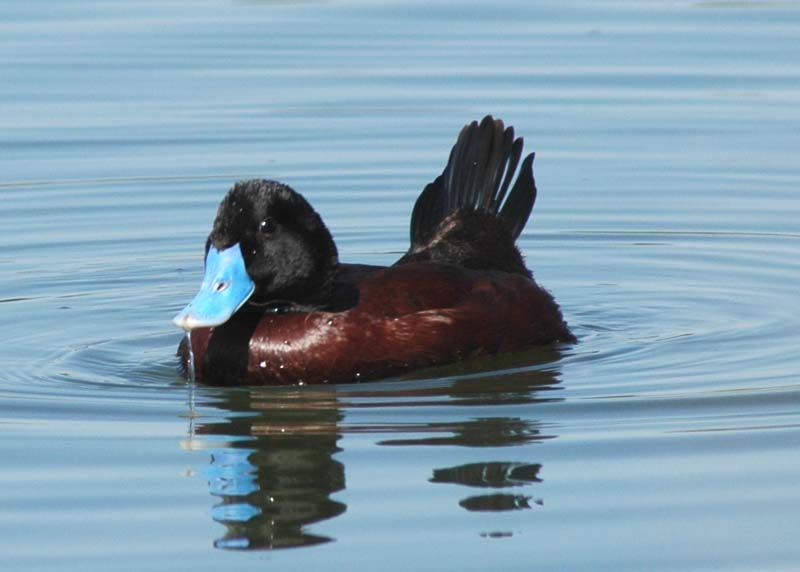
The Blue-billed Duck is one of Australia’s hidden treasures — a shy, stiff-tailed duck that prefers to stay tucked away in calm wetlands. What makes it stand out is the male’s bill, which turns a brilliant sky-blue during breeding season. Outside of that time, it stays a darker slate-blue, still noticeable but not quite as bright. His rich chestnut body completes the look, making him one of the most striking ducks you can spot on Australian waters. The female, however, keeps things subtle with her dark brown plumage that blends perfectly with the reeds. Though quiet and secretive, these ducks are strong divers, feeding on small insects and plants below the surface.
2. Ruddy Duck
Scientific Name: Oxyura jamaicensis
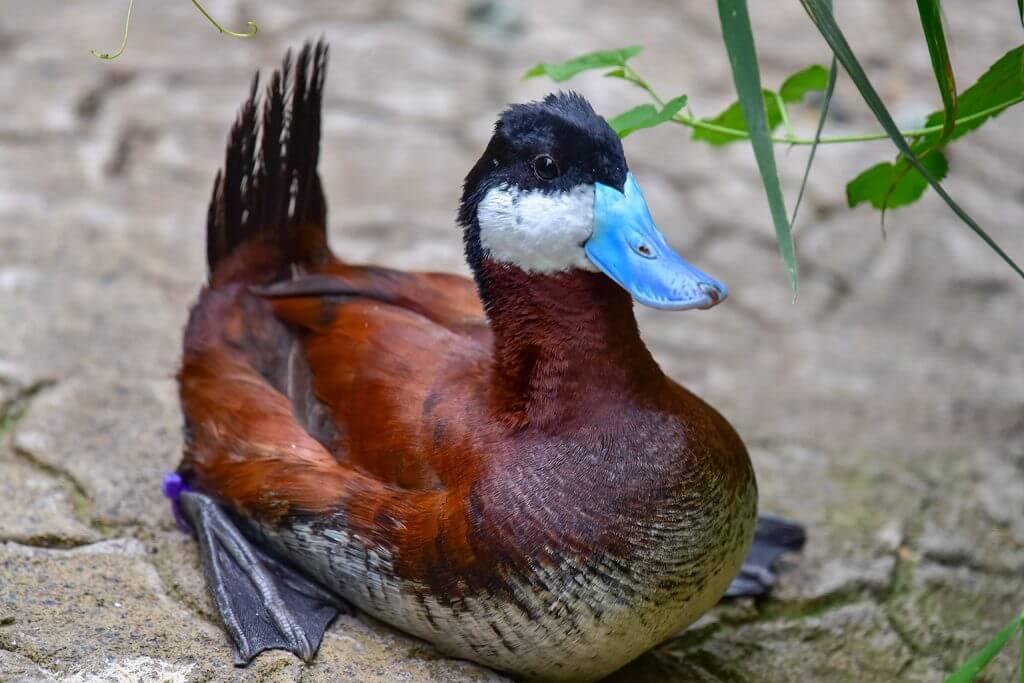
The male Ruddy Duck’s bright blue bill and chestnut body make him look like he’s ready for a summer celebration. His bill, wide and scoop-shaped, is perfect for foraging underwater — and it’s one of the easiest ways to identify him. During the colder months, his colors fade to dull gray and brown, but that sturdy blue bill is unforgettable once you’ve seen it. Females, on the other hand, wear softer brown tones with a faint stripe across their pale cheeks. They’re excellent swimmers, often bobbing along with their stiff tails pointed upward, a funny and familiar sight to duck watchers everywhere.
3. Lake Duck
Scientific Name: Oxyura vittata
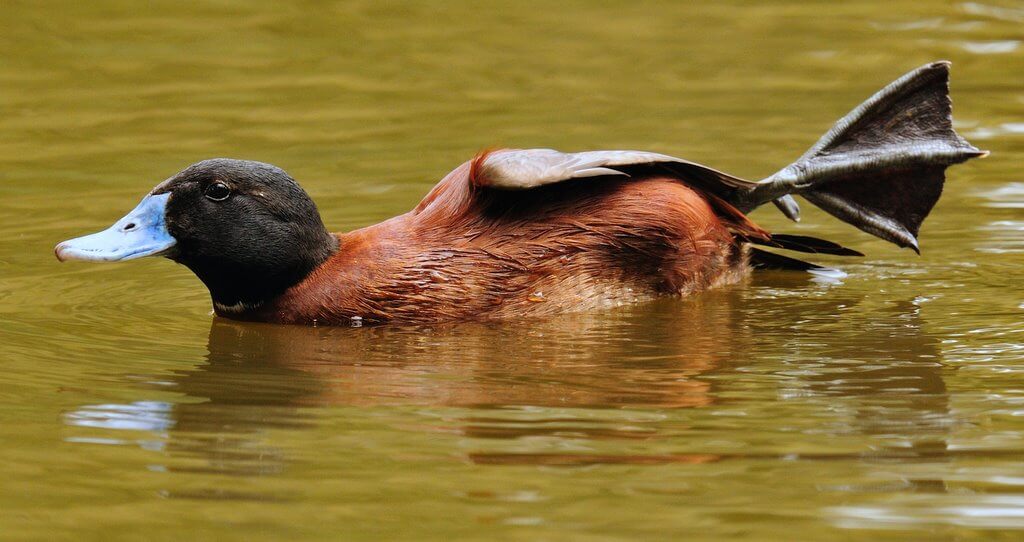
The Lake Duck, found in South America, is another stiff-tailed species known for its blue bill, especially in males. It’s often seen resting or sleeping quietly on open lakes or among reeds, its bill showing a soft blue tint that stands out against dark plumage. Males have a squarer head and slightly longer tail than similar species like the Andean Duck, while females are patterned in browns with pale face markings. Though they spend a lot of time napping, Lake Ducks are excellent divers and can disappear underwater for surprising distances.
4. Redhead
Scientific Name: Aythya americana
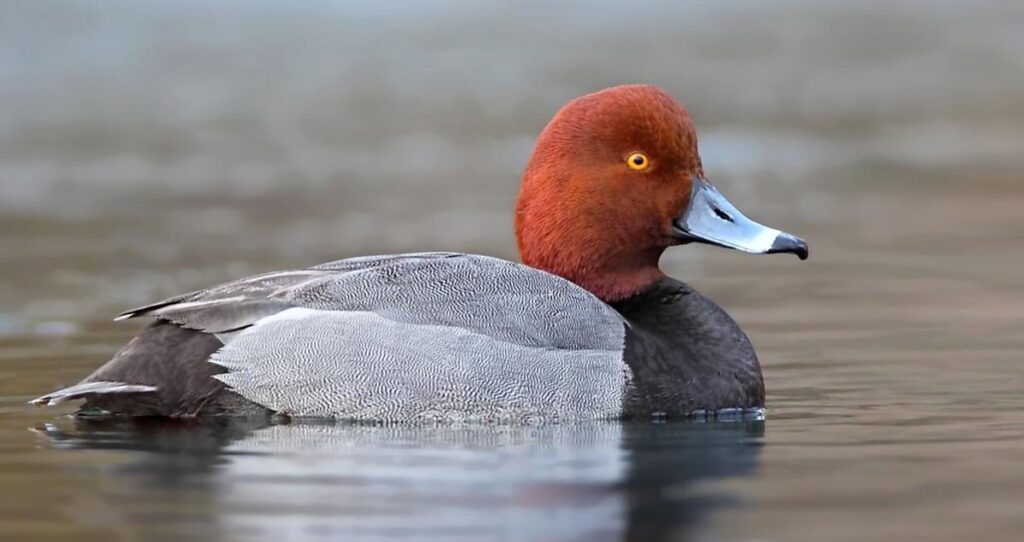
The Redhead is a handsome diving duck from North America that’s easy to recognize thanks to the male’s copper-red head and pale blue bill with a black tip. That bill color is especially striking during breeding season, glowing softly against the bird’s black chest and gray back. The female Redhead is less showy, dressed in warm brown tones with a slate-colored bill that carries a faint blue ring. These ducks are strong divers, using their broad bills and webbed feet to search for plants and small creatures beneath the surface.
5. Northern Pintail
Scientific Name: Anas acuta
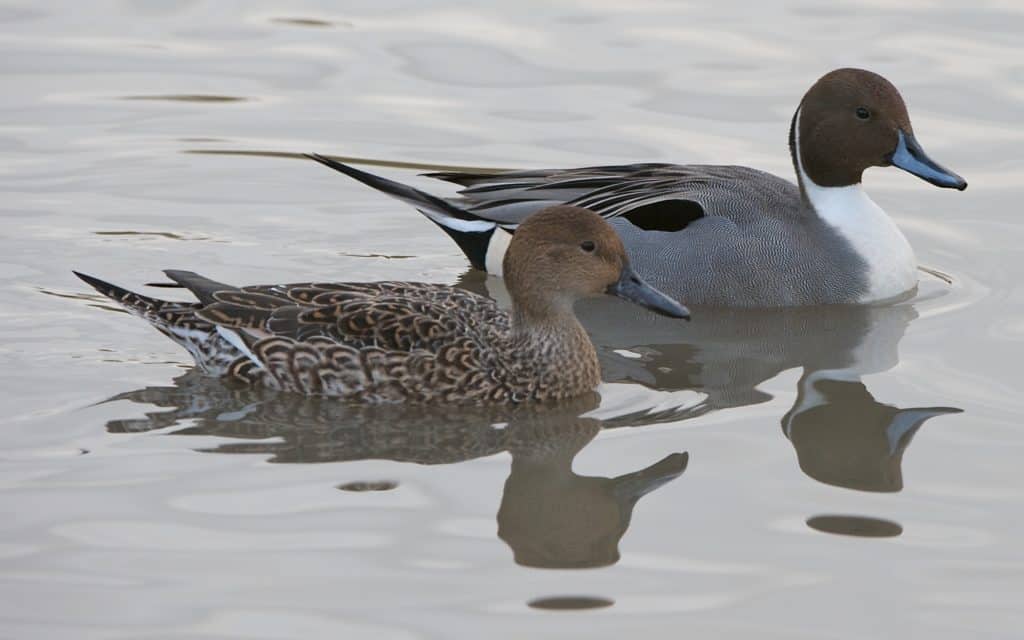
The Northern Pintail is an elegant and graceful duck that’s easy to recognize, especially by the male’s long, pointed tail feathers — the very feature that gives this species its name. Both males and females have blue-grey bills, adding a cool touch of color to their otherwise earthy tones. The drake is particularly eye-catching, with a chocolate-brown head and a thin white stripe that runs beautifully down his neck to his white chest. The female, on the other hand, wears soft brown feathers that blend perfectly with marsh grasses. Pintails are dabblers, feeding by tipping forward in shallow water to nibble on plants and small insects. They love open wetlands and are often seen in large flocks during migration.
6. Greater Scaup
Scientific Name: Aythya marila
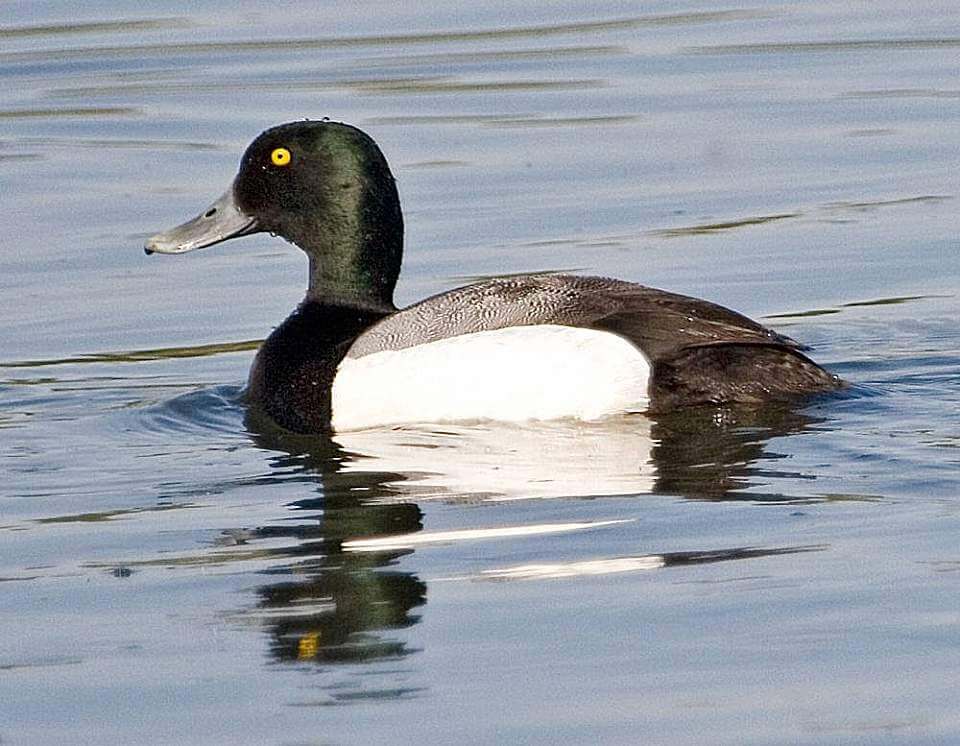
The Greater Scaup is a hardy diving duck often found on northern lakes and coastal waters. One of its standout features is its light blue-grey bill, which birdwatchers sometimes call “blue.” Males are sleek and handsome, with dark heads that shimmer green or purple depending on the light, black chests, and white bellies. Females are mostly brown but share that same blue-tinted bill, along with a small white patch near the base of it. Greater Scaups are skilled divers that search underwater for plants, insects, and small shellfish. They’re also very social, forming large, noisy flocks in winter.
7. Lesser Scaup
Scientific Name: Aythya affinis
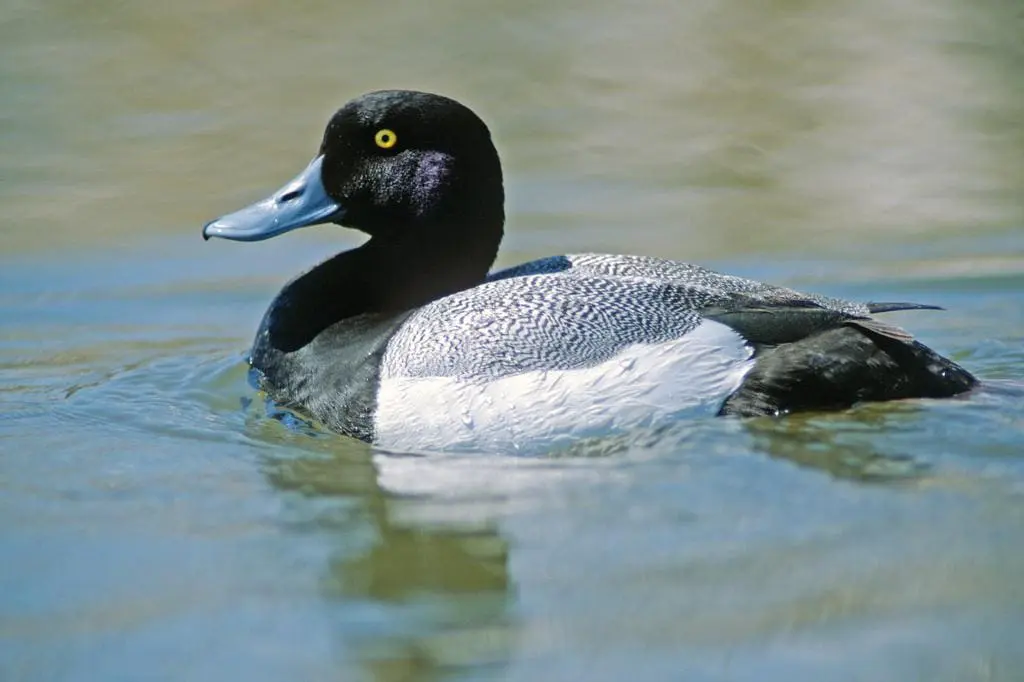
The Lesser Scaup looks quite similar to its larger cousin, the Greater Scaup, but it’s a little smaller and has a subtle peaked shape to its head. Both male and female Lesser Scaups have beautiful blue-grey bills, a helpful clue when spotting them in the wild. The drake shows off a glossy black head, chest, and tail with white sides and a finely patterned back. The female wears deep brown feathers with a faint white band around the base of her bill. Lesser Scaups are active and agile divers, plunging below the surface to find seeds, aquatic plants, and snails. They often gather in flocks called “rafts,” where their soft blue bills glint in the sunlight as they drift together across the water.
8. White-headed Duck
Scientific Name: Oxyura leucocephala
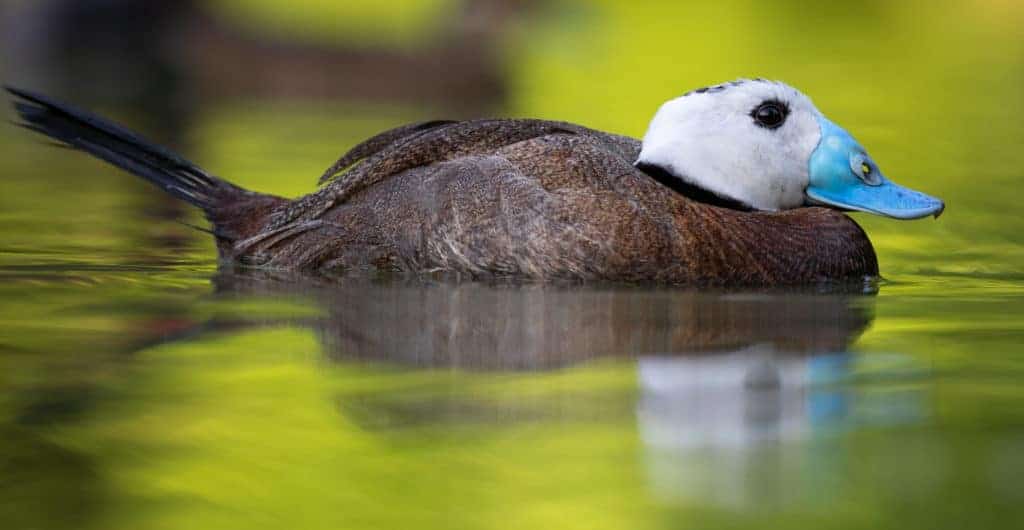
The White-headed Duck is a small, sturdy diving duck known for its bold colors and strong personality. The male is easy to recognize with his striking white head, glossy black crown, and bright blue bill that seems to shine even from a distance. His body is a warm reddish-brown, while the female has a darker, duller bill and brown feathers for camouflage. These ducks prefer quiet lakes surrounded by thick vegetation, where they can dive and feed safely on underwater plants and small creatures. Instead of flying off when alarmed, they often swim quickly away or dive under the water to hide.
9. American Wigeon
Scientific Name: Mareca americana
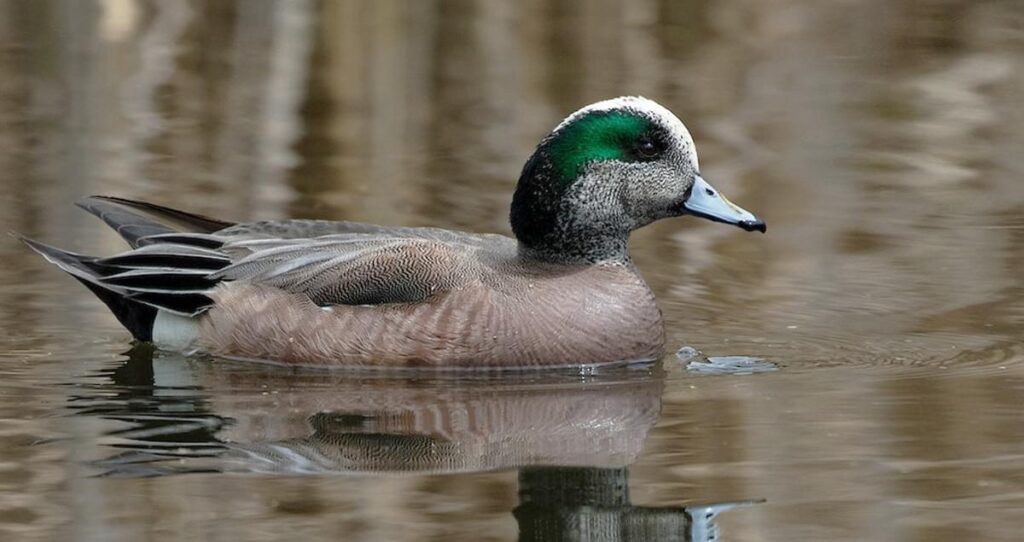
The American Wigeon is a medium-sized duck that’s easy to spot thanks to its short neck, round head, and small blue-gray bill with a neat black tip. Both males and females share this lovely pale blue bill, which looks even more noticeable against their soft feathers. The drake, or male, is especially eye-catching — his head has a green patch around the eyes and a creamy white cap that shines like a little helmet, earning him the nickname “baldpate.” Females wear more subtle shades of brown and gray but still have that same charming blue-tinted bill. Wigeons love open wetlands, ponds, and marshy fields where they graze on plants and occasionally snatch food from other ducks — a habit that makes them quite cheeky!
10. Eurasian Wigeon
Scientific Name: Mareca penelope
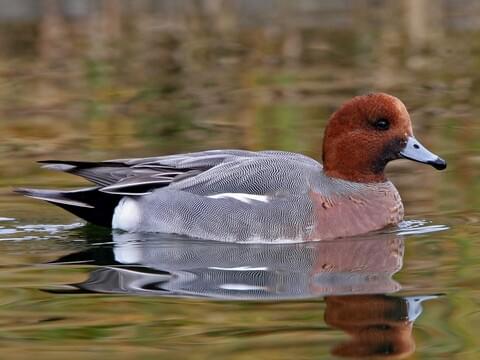
The Eurasian Wigeon is the close cousin of the American Wigeon, and they even look a bit alike. Both have those soft, blue-gray bills tipped with black, but the Eurasian drake stands out with his chestnut-colored head and creamy yellow crown. His body is mostly gray with a pinkish chest and striking white patches on the wings that flash brightly in flight. The female is more modest, wearing shades of warm brown or gray, but she too has that gentle blue bill. These ducks are often found in flocks on lakes, estuaries, and flooded fields, dabbling for plants near the surface.
11. Masked Duck
Scientific Name: Nomonyx dominicus
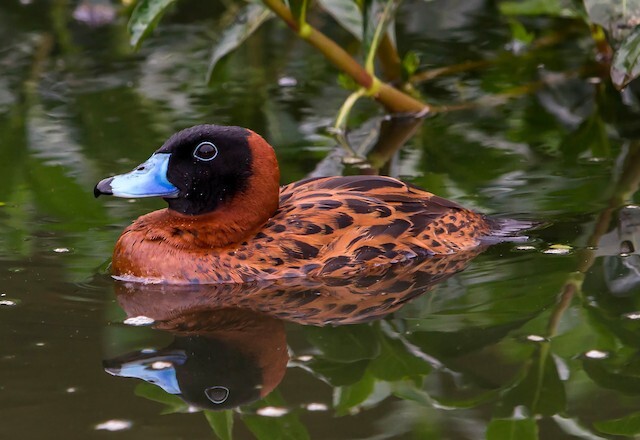
The Masked Duck is a tiny, secretive duck with a lot of personality. It’s a stiff-tailed species, meaning it often holds its tail upright like a little flag. Males in breeding season are striking, with chestnut bodies, black faces (the “mask” that gives them their name), and bright blue bills that pop against their dark feathers. Females and young ducks are duller, with brown plumage and grayish bills, perfect for hiding among reeds. These ducks live in quiet tropical wetlands, often surrounded by thick vegetation. They’re great divers and can disappear under the water in a flash when startled — making that glimpse of a glinting blue bill even more special.
12. Philippine Duck
Scientific Name: Anas luzonica
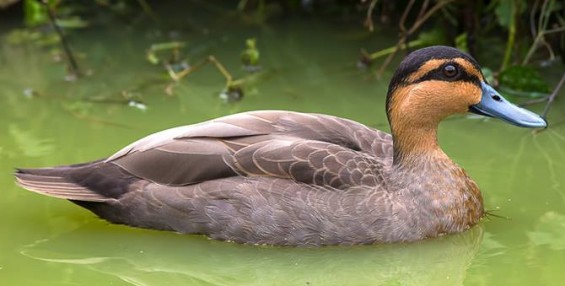
The Philippine Duck is a beautiful and rare duck found only in the Philippines. It’s fairly large, with a cinnamon-colored head and neck, a black stripe that runs from the bill through the eyes, and a body covered in soft gray-brown feathers. Its most distinctive feature is its bluish-gray bill — wide, smooth, and elegant. Both males and females share this color, giving them a gentle, refined look. These ducks love freshwater lakes, rice fields, and marshes, where they feed on plants and small fish.
13. Steller’s Eider
Scientific Name: Polysticta stelleri
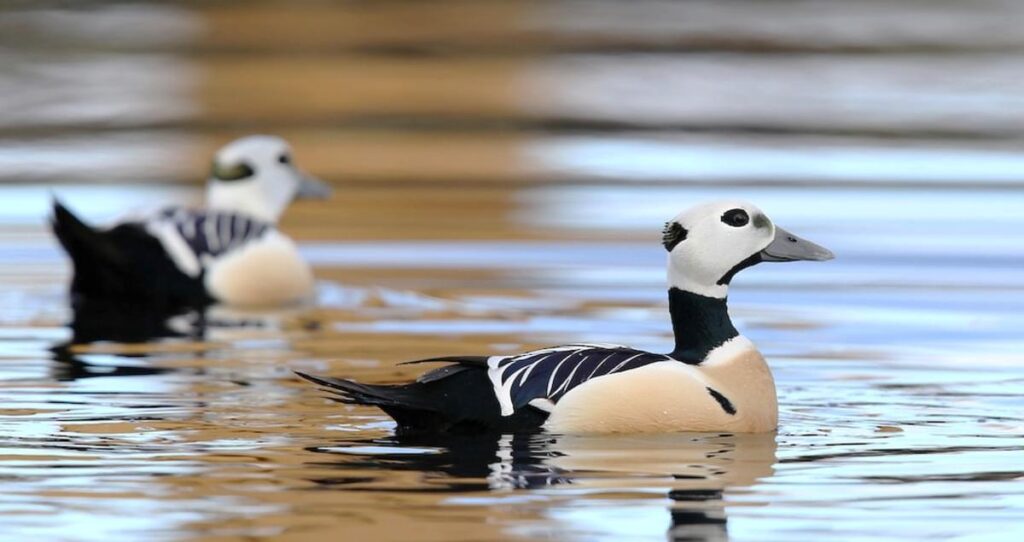
Steller’s Eider is the smallest and perhaps the most striking of all the eider ducks. The males are real showstoppers in their breeding colors — with white heads, black caps, and patches of soft green behind the eyes. Their chests glow with a warm cinnamon tone marked by a neat black spot, and their wings shimmer with a bluish-purple tint that seems to change in the light. Their bills are thick and a smooth blue-gray color, matching their legs and feet. Females, on the other hand, wear a cozy coat of brown feathers that keeps them well camouflaged in their Arctic nesting grounds. These ducks love coastal waters and shallow tundra ponds, diving expertly for mollusks and crustaceans.
14. Southern Pochard
Scientific Name: Netta erythrophthalma
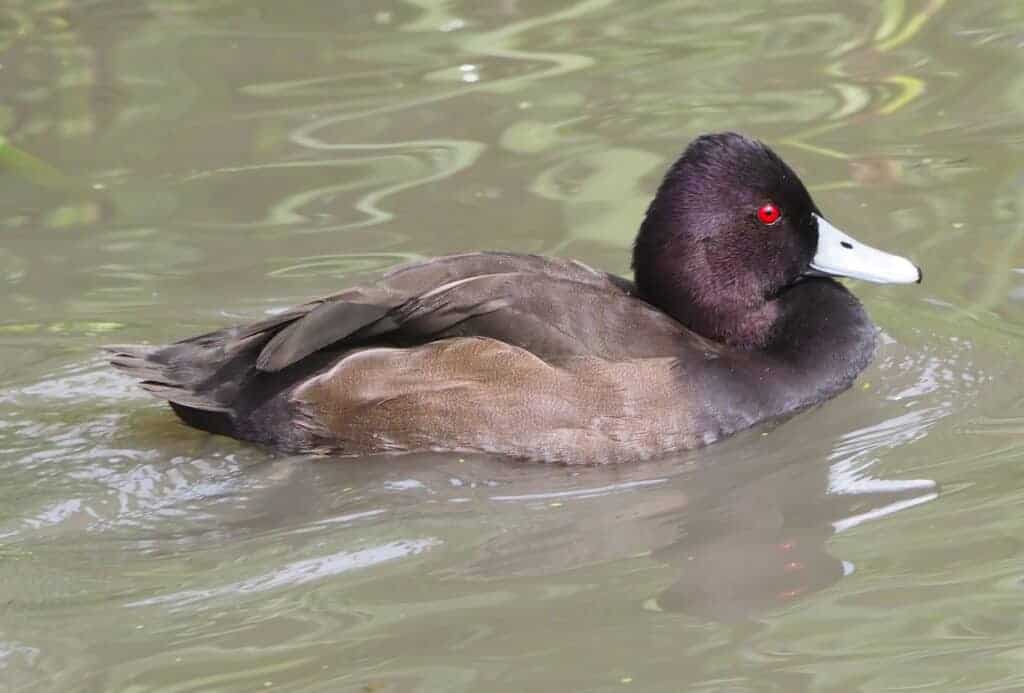
The Southern Pochard is a handsome diving duck found across Africa and South America. Both males and females have blue-gray bills that stand out against their dark plumage. Males are chocolate-brown with bright red eyes, while females are a bit paler and more softly colored. You’ll often see them swimming low in the water or diving gracefully for aquatic plants and insects. They prefer calm freshwater lakes, ponds, and dams — especially those surrounded by vegetation. Once, these ducks were great travelers, but now many live more settled lives thanks to man-made dams providing perfect homes.
15. Tufted Duck
Scientific Name: Aythya fuligula
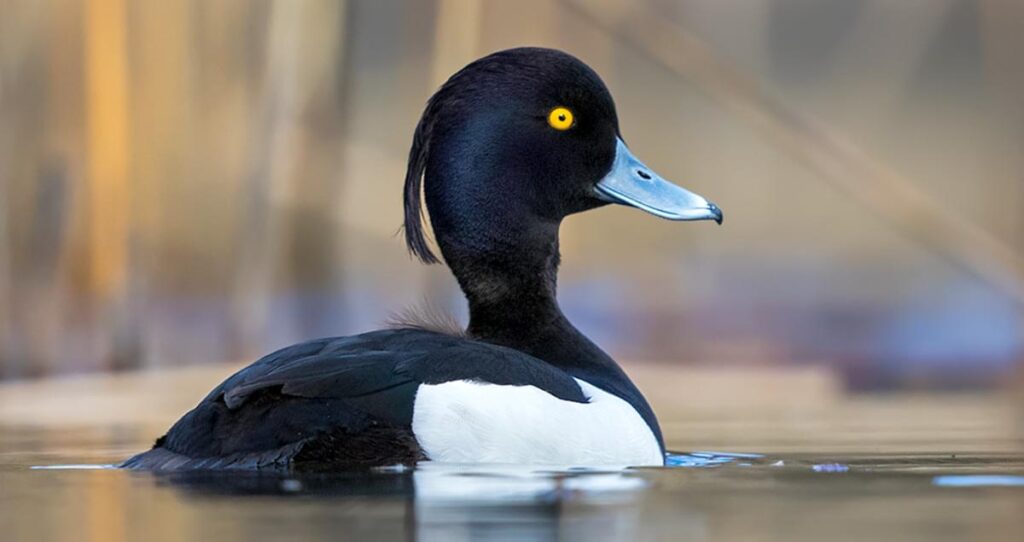
The Tufted Duck is easy to recognize — especially the male with his glossy black body, bright white sides, and a cute tuft of feathers sprouting from the back of his head. His bill is a clear bluish-gray with a tiny black tip, giving him a smart, polished look. Females are brown and more subtly marked, sometimes showing a bit of white near the base of the bill. These ducks are common on lakes, reservoirs, and slow-moving rivers, often seen diving for mussels, snails, and plants. When the sunlight hits just right, that soft blue bill almost gleams against the dark plumage — a small but beautiful detail that makes the Tufted Duck a favorite among bird lovers.
16. Harlequin Duck
Scientific Name: Histrionicus histrionicus
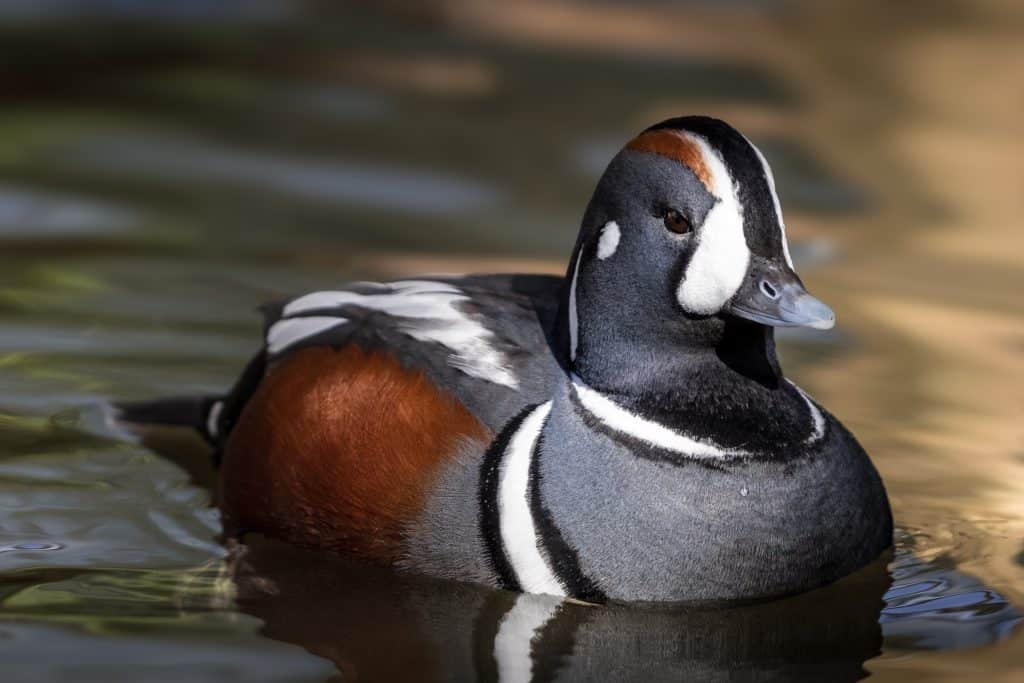
The Harlequin Duck is one of the most colorful and charming ducks you’ll ever see. The male looks like he’s dressed for a masquerade — slate-blue body, chestnut sides, and bold white spots and stripes around his head and neck. His blue-gray bill adds a cool touch to his already eye-catching look. Females, though much plainer in brownish-gray, still show three neat white spots on their faces that make them easy to recognize. These ducks love fast-moving mountain streams and rocky coastlines, where they dive and tumble through the waves with ease.
17. Blue-winged Teal
Scientific Name: Spatula discors
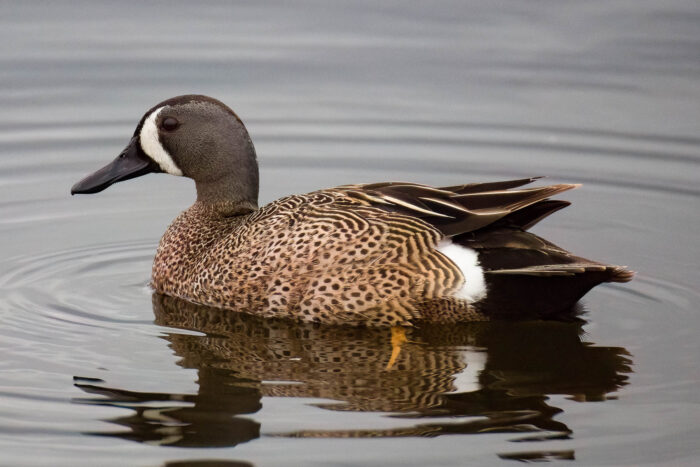
Blue-winged Teals are small, graceful ducks often seen zipping low over marshes and ponds. Both males and females have blue-gray bills, but it’s the male’s gray-blue head and crisp white crescent in front of the eye that really catch attention. During flight, their sky-blue wing patches glimmer beautifully in the sunlight — one of the easiest ways to tell them apart from other dabbling ducks. These ducks are early migrators, among the first to head south when autumn arrives. Whether they’re dabbling in shallow water or resting in grassy wetlands, that subtle blue bill is one of their quiet trademarks.
18. Puna Teal
Scientific Name: Spatula puna
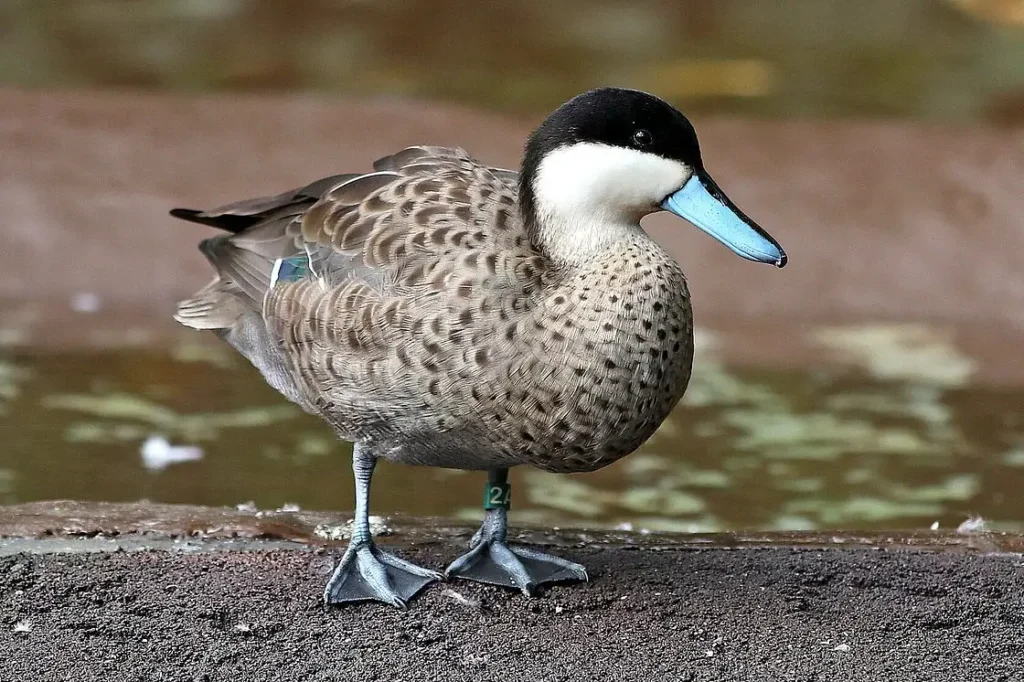
The Puna Teal is a lovely duck of high Andean lakes, known for its striking bill — a powdery light blue marked with a fine black line down the middle, almost like it’s been painted by hand. Its creamy face and black cap give it a polished, almost elegant look. The rest of the body is softly patterned in coffee and gray tones that blend beautifully into its surroundings. These ducks are calm and gentle by nature, often floating quietly in pairs or small groups.
19. Maccoa Duck
Scientific Name: Oxyura maccoa
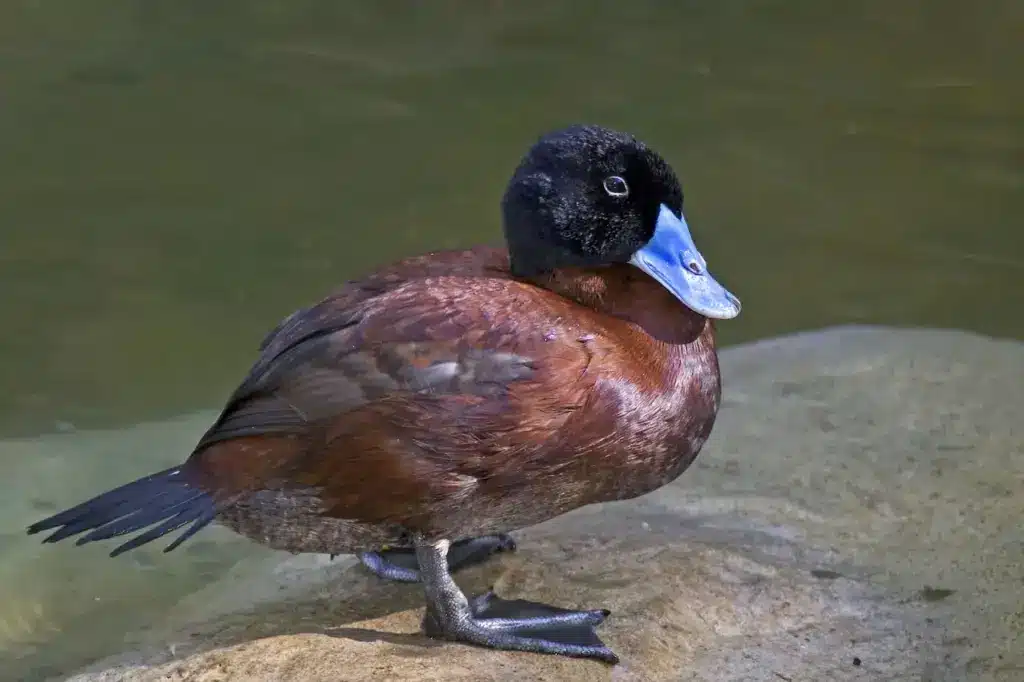
The male Maccoa Duck with his cobalt-blue bill and deep chestnut body, looks as if he’s been dipped in color. His jet-black head and tail complete the sharp contrast, making him one of Africa’s most striking ducks. The female is more softly colored, wearing shades of brown with a pale throat and a grayish bill. Like other stiff-tailed ducks, the Maccoa is an excellent diver, disappearing underwater with a quick flick of its tail.
20. Fulvous Whistling-Duck
Scientific Name: Dendrocygna bicolor
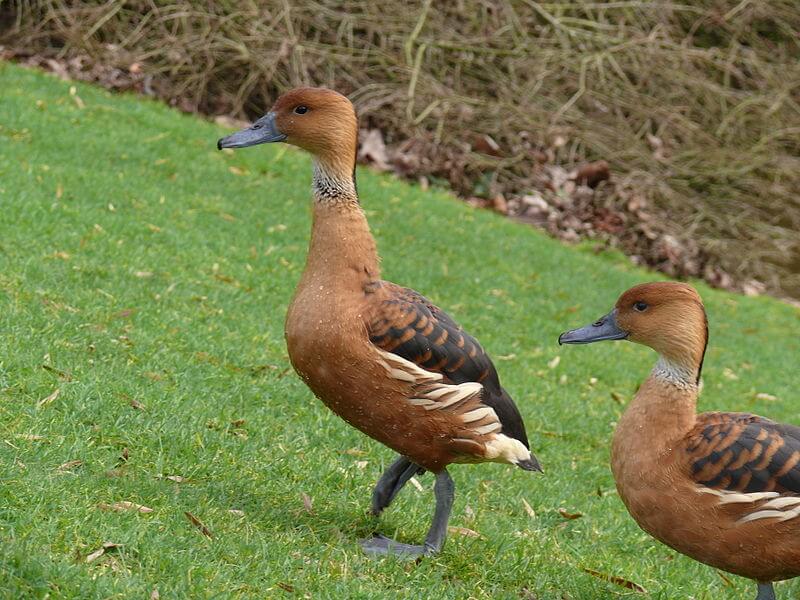
The Fulvous Whistling-Duck is a tall, elegant duck with long legs and a sleek, gray-blue bill that matches its graceful look. Its warm, reddish-brown body and creamy markings make it easy to recognize, especially when you hear its cheerful, whistling call ringing over the wetlands. These ducks love shallow lakes, rice fields, and marshes filled with tall vegetation where they can feed on seeds and plants. They often gather in large, friendly flocks — a delightful sight when they all take off together, flashing a white band across their tails. Pairs usually stay together for life, taking turns caring for their eggs and ducklings.
21. Andean Duck
Scientific Name: Oxyura ferruginea
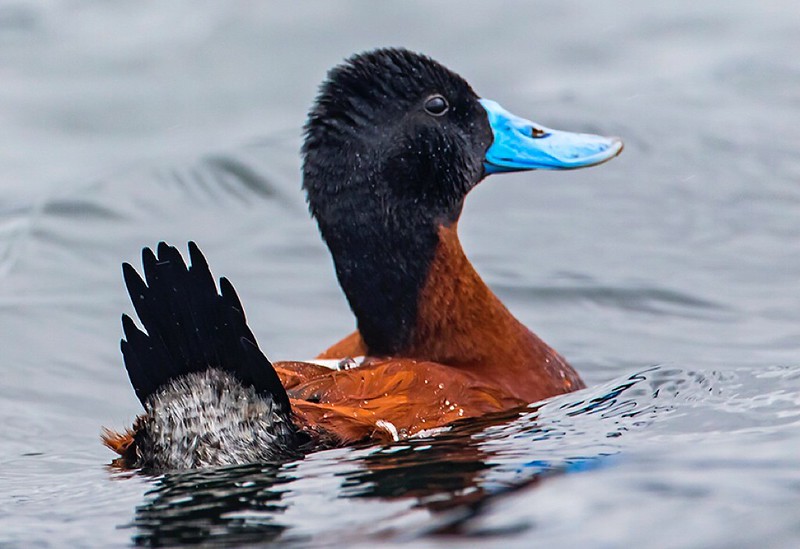
High in the Andes Mountains lives the sturdy little Andean Duck, a close cousin of the Ruddy Duck. It’s a compact bird with a stiff tail that it often points upward, as if showing off its balance. During the breeding season, males turn a rich chestnut color and sport a bright blue bill that stands out beautifully against their all-black faces. When winter comes, the color fades to a softer gray-brown, but that unique shape — short neck, thick bill, and cocked tail — always gives it away. These ducks are strong divers and spend much of their time underwater, feeding on small aquatic creatures.
22. Chestnut Teal
Scientific Name: Anas castanea
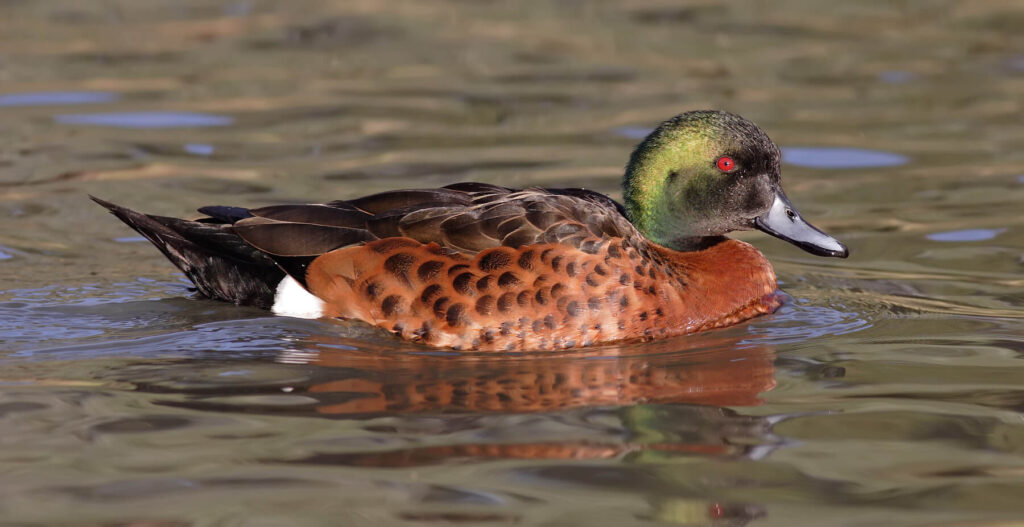
The Chestnut Teal is a stunning Australian duck with, you guessed it — a touch of chestnut on its body and a lovely blue-gray bill. The male stands out with a glossy green head and a rich, dark brown chestnut body, while the female wears more modest shades of brown that help her blend into wetlands and estuaries. These ducks aren’t picky about water; they’ll happily paddle around saltwater bays or freshwater ponds. The female’s laugh-like quack is hard to miss — it’s one of the easiest ways to know they’re nearby! Whether you’re watching them in Tasmania or mainland Australia, that cool blue bill gives the Chestnut Teal a refined, almost polished look that’s hard not to admire.
